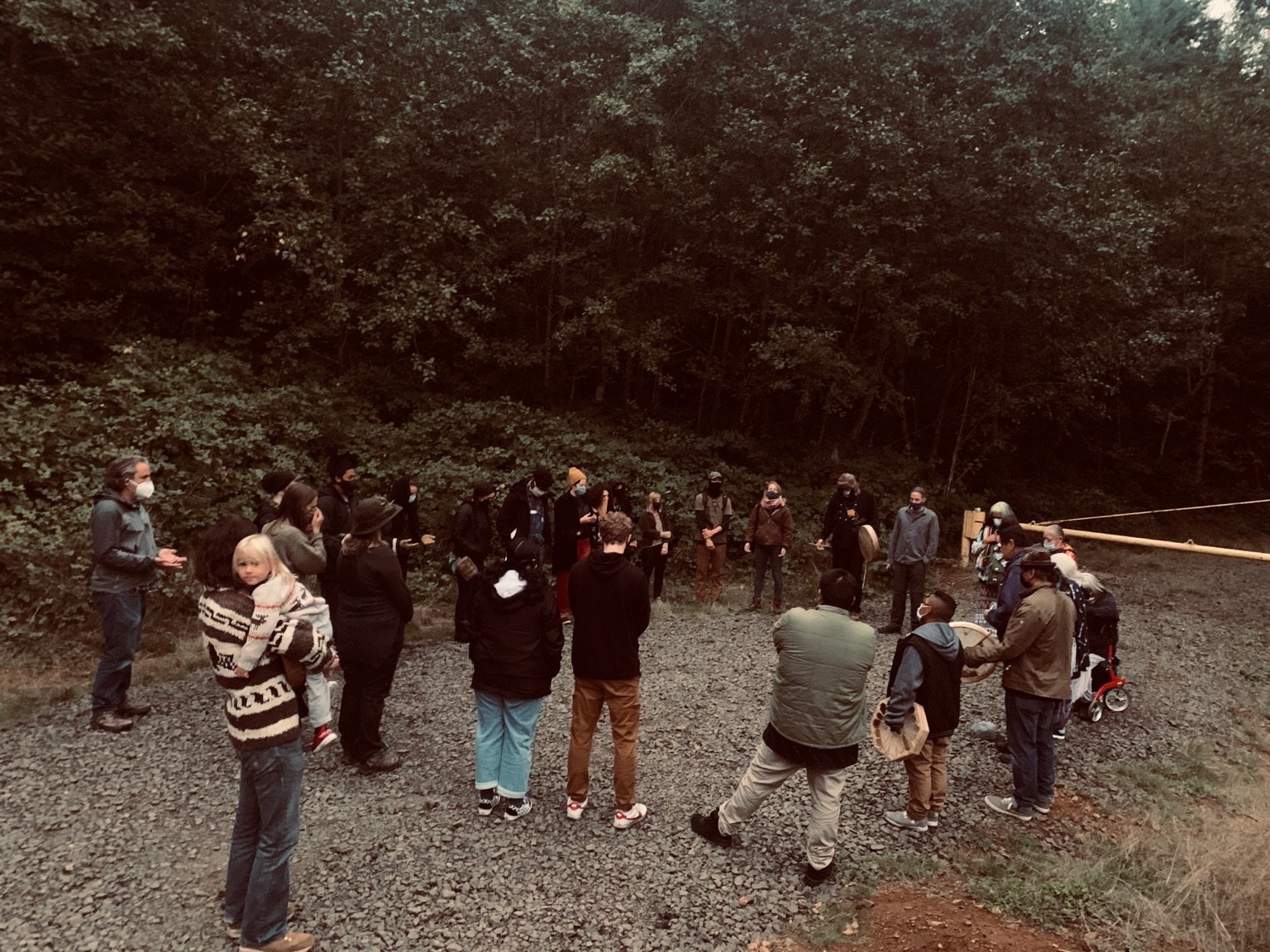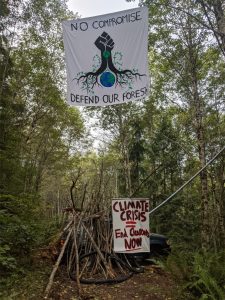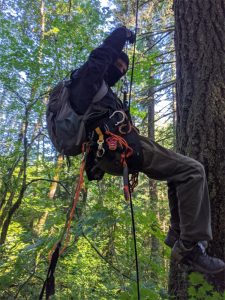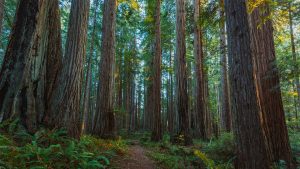
by DGR News Service | Oct 15, 2020 | Obstruction & Occupation
The Capitol State Forest, Washington — Early Wednesday afternoon just as the fog melted off, a convoy of trucks from at least four different law enforcement agencies parked on a logging road for an unannounced raid on a camp of forest protection activists, sweeping the camp away and leaving one man in the forest canopy tied to a unique contraption that continues to impede work on the controversial “Chameleon” timber sale. The officers came from the Thurston County Sheriff’s Office, the Washington State Patrol, the state Fish and Game Department, and the Department of Natural Resources (DNR) which planned and sold the timber sale and oversees all of the Capitol State Forest. They temporarily closed the roads to through traffic while they cleared the activists from the camp.
Ian Frederick, 29, a teacher from Olympia, was on the ground making coffee when the cops arrived. “There were just so many of them,” he said. “It seems like a lot of force to bring to deal with two unarmed civilians eating lunch.”
The two activists were briefly detained before being allowed to walk away while the officers attempted to negotiate with the remaining “tree-sitter” who continued to block the logging road. The DNR law enforcement eventually brought in spotlights and a generator and began to prepare for a siege of the tree-sit.
The man in the treesit was John “Tree’Angelo” Barksdale. Mr. Barksdale, 34, an outdoor educator from Tumwater, has watched with dismay over the past several years as the DNR has systematically clear-cut most of its remaining old-growth stands. An avid hiker, he’s seen many of his favorite local trails turned to moonscapes.
“Unit 1 of Chameleon is some of the most intact forest, the best habitat left across one hundred thousand acres,” Mr. Barksdale said. “If we want all this to actually be a forest and not just an oversized tree plantation, we need to save at least something. We can’t clear-cut all of it.”
Mr. Barksdale has used years of climbing experience to erect a unique “dunk-tank” platform atop an old-growth douglas-fir tree, tied to an abandoned Ford Explorer parked across the proposed logging road. If the car moves, his platform drops. It’s about one hundred feet down to the steep slopes of the forest below. Mr. Barksdale claims to have plenty of food and water and says he is prepared to wait out the DNR indefinitely.
“I’ve always wanted to tree-sit,” he says. “I love trees. I love camping. I can work remotely out here and attend Zoom meetings from right here on the platform. It’s super dreamy up here, and I’m trying to save these trees. I can’t think of anything else I’d rather be doing.”
The protest camp, which was started ten days ago by a few friends of Mr. Barksdale, quickly picked up support from local hunters, fishermen and ATV users concerned about the health of the forest. Protectors of the Salish Sea, an indigenous water advocacy group, held space with songs and prayers at the blockade on Saturday. Multiple community groups across Thurston County have come out in support of the blockade and are calling for the cancellation of the timber sale.
The tree sit came to an end several days later when storms forced Mr. Barksdale to descend.

![[Media Release] Forest Defenders launch blockade to stop logging of the ‘Chameleon’ Timber Sale](https://dgrnewsservice.org/wp-content/uploads/sites/18/2018/07/sabotage-against-logging.jpg)
by DGR News Service | Oct 2, 2020 | Direct Action, Obstruction & Occupation, The Solution: Resistance
A blockade has been launched at the Capitol State Forest, Washington to stop clearcut logging. Learn more about the blockade.
Forest Defenders today have launched a blockade to prevent the clear-cut logging of a 100-year-old forest west of Olympia on the traditional territory of the Chehalis people. The forest, part of the critically endangered Puget Lowland Eco-Region, was auctioned off by the Department of Natural Resources as the “Chameleon Timber Sale” to the Elma based Murphy’s Logging Company. Protesters have set up a blockade preventing road building and logging in one of the largest and most biodiverse units of the timber sale. The site is home to a late-successional Douglas Fir forest (over 100 years since it was last logged), which is gaining old growth characteristics that support endangered wildlife.
“It’s absurd,” one protester said, “That the state of Washington under the leadership of the ‘climate change candidate’ Jay Inslee is still sanctioning clearcut logging on public lands.” Recent fires have been testament to the northwest’s vulnerability to the climate crisis, yet our elected officials are carrying on a business-as-usual approach as the world burns. Older forests such as those targeted by the timber industry not only store massive amounts of carbon and support tremendous biodiversity, but are less prone to wildfire and are more resilient to climate change.
“Not only are we in a climate crisis but we are in an ecological crisis, with more species going extinct today than at any point in millions of years. Every wild place that we can save today, every species we save from extinction will quite literally shape the future of life on earth for millions of years.”
In light of the ongoing climate emergency and ecological apocalypse, protesters are demanding:
An end to industrial logging on public lands in the State of Washington.
A complete ban on clear-cut logging in the State of Washington.
The return of “Capitol Forest” to the Chehalis, Nisqually, and Quinault peoples, for DNR to completely fund the restoration of that area, and for DNR to return all stolen lands.
Until these demands are met and the Chameleon timber sale is canceled, protesters will maintain and expand the blockade to prevent industrial clear cutting on public lands.

by DGR News Service | Aug 9, 2019 | Biodiversity & Habitat Destruction
By Max Wilbert / Images: public domain
Here is a familiar fact to many people across the United States and the world: the Redwoods of Northern California are the tallest trees in the world at nearly 400 feet.
This is both true and false. It’s true because right now the redwoods are the tallest trees. But it’s false because not long ago, that wasn’t the case.
The tallest known redwood is 379 feet tall. But historical accounts are full of references to Douglas Fir trees 400 feet tall and more. One tree in the lower North Fork of the Nooksack River Valley is thought to have been 465 feet tall, probably the largest known tree ever recorded anywhere on the planet. And it wasn’t alone.
 Micah Ewers of Portland writes, “If this was just a freak occurrence, I would write it off. But I’ve collected 90 to 100 reports of 300- to 400-foot Douglas firs. A hundred years ago, trees rivaling the height of the redwoods were fairly common. The whole Puget Sound was just filled with giant trees.”
Micah Ewers of Portland writes, “If this was just a freak occurrence, I would write it off. But I’ve collected 90 to 100 reports of 300- to 400-foot Douglas firs. A hundred years ago, trees rivaling the height of the redwoods were fairly common. The whole Puget Sound was just filled with giant trees.”
His research found references to many trees that would be considered world record holders today on the sites of current downtown Seattle and downtown Vancouver in British Columbia.
So if you find yourself among the skyscrapers of Seattle or Vancouver, or wandering through the neighborhoods and suburbs or young woodlands of the territory in between, take some time to reflect that where you are walking was not that long ago full of the largest trees on the planet, trees who were killed for profit, for greed, for colonization, for capitalism, for growth, for progress.
Followup:
Micah Ewers responded to this post with an extensive comment below. We’re copying the text here. Thanks Micah!
Thanks for the mention. Yeah the size of forest that was growing in Seattle was astounding. 250 – 300 foot trees were common back then. I am trying to follow up on an old report of a 412 footer said to have been logged around Tacoma, and another big tree 17.8 feet in diameter east of Seattle was reported in 1909 at over 400 feet, the tree was so big that the Puget Sound railroad had to be built around it. Another fir tree reported in Chehalis County in 1893 was measured with survey instruments at over 400 feet, and 17 feet diameter. There were even reports of 300 foot cedars, and 400 ft Sitka Spruce, 20 ft in diameter in Washington and Oregon 100 years ago.
If you look up “Ravenna Park” in a google image search you can find old post cards which give the size of some of the trees that used to grow in Seattle’s most treasured city Park,… Before they were all cut down for quick cash between the 1910’s – 1920’s… the excuse was that the trees were dying and needed to come down, which may have been true for one, but not the whole stand. Those fantastic trees were listed on the post cards as from 270 to about 400 feet in height and 10 to 12, even 14 feet in diameter. Age estimates were between 1,000 and 2,000 years for the oldest of them. Just imagine these massive old beasts jutting out of the little creek and valley near the University district.
Same story in Vancouver, only at least Stanley Park was preserved and wind had blown down the last of the 325 footers in the park in 1926. Portland Also had some 300 – 330 footers in its vicinity, the last of them logged in the 1910’s – 20’s.
I think the redwoods and Douglas fir were actually tied for tallest tree, only that the tallest reported Redwoods I have discovered were up to 424 foot circa. 1886, while the highest reports for Douglas fir is 465. I actually heard a story from a guy in a Gardenweb forum who claimed his father had felled a 480 foot fir in the Black Hills, near Bordeaux, Washington around 1930– although, this is second hand, so it remains an unsubstantiated claim, but the 2008 study on theoretical limits of Douglas fir height by Oregon State University came up with a range of 99 – 145 meters as the possible limits for Doug fir (325 – 475 ft), whereas a 2004 study on Coast Redwoods yielded a slightly smaller limit of 400 – 430 ft.. So it may well be that Douglas fir was the supreme master of stature after all! Redwood holds the title for now, although it wouldn’t surprise me if a few hidden giant Douglas fir, over 350 feet high, still exist hidden in some valley awaiting discovery.
The last real big fir that has survived into modernity (which has been publicly reported anyways) was the “Mt. Pilchuck giant”, fir tree cut down on October 22, 1952 near the small town of Verlot, Washington. The big tree, 700 years old, was reported to be over 350 foot high, 11 ft 6 inches diameter and 30,000 board feet. From that point on, records are few for the big trees over that height range, except of course, the redwoods in California which have about 300 trees alive today of that height. (Impressive, considering 96% of old growth Coast Redwood has been clear-cut).
Editor’s Note: this piece was originally published in 2015, and is being republished here with a few minor edits.

by DGR News Service | Jul 31, 2019 | Property & Material Destruction, White Supremacy
In mid-July, an armed attack on ICE facilities in Tacoma, Washington took place. Here’s a brief summary of what happened:
Will Van Spronsen… was killed [on July 13th] while carrying out a raid against a migrant concentration camp in Tacoma, Washington State. Van Spronsen is thought to be the first person killed attempting to take direct action against the US deportation system, which for months has faced heavy criticism over its use of concentration camps to break up families and detain migrant children.
The 69-year-old, known as an anti-fascist and campaigner against migrant detention, was shot dead by four police officers as he attempted to set fire to deportation buses stationed at the Northwest Detention Center (NWDC), a few hours after a peaceful protest against the facility had been held.
– Via Freedom News
DGR Response to Armed Attack on ICE Facility
Deep Green Resistance recognizes, first and foremost, that Immigration and Customs Enforcement is nothing more than the paramilitary wing of the settler nation. Tacoma, like all of so-called North America, rests on stolen land – as an illegitimate occupier, this government has no right to establish or enforce imaginary borders across the territory of the Coast Salish people or any other indigenous community.
DGR affirms the struggle against all forms of xenophobia and white supremacy, and we stand in solidarity with those who resist ICE and its glorified ethnic cleansing. Direct action of this kind against the American immigration enforcement is justified and moral.
However, we also affirm the need for strategic, organized resistance that is capable of striking decisive blows against the settler state. Lone-wolf attacks of this nature are unlikely to achieve much beyond the symbolic. While we honor Van Spronsen’s bravery, we encourage activists to evaluate actions like these and consider more effective methods and strategies.
Decisive Ecological Warfare, the strategy of Deep Green Resistance, provides a detailed roadmap for creating and maintaining a militant resistance movement capable of overturning the white supremacist settler state. As aboveground activists, we must work to harness and direct the kind of fury and passion that leads to attacks like these, away from individual expressions of rage and towards organized militancy on behalf of the planet and all oppressed peoples.
by DGR News Service | May 7, 2019 | Biodiversity & Habitat Destruction
By Will Falk and Sean Butler / Voices for Biodiversity
On December 18, 2018, the Center for Biological Diversity and the Wild Fish Conservancy threatened the Trump administration with a lawsuit under the Endangered Species Act (ESA) for allowing salmon fisheries to take too many salmon, which the critically endangered Southern Resident orcas depend on for food.
The impulse to protect the orcas is a good one. Southern Resident orcas are struggling to survive — only 75 remain. According to the statement by the Center for Biological Diversity and Wild Fish Conservancy, “The primary threats to Southern Resident killer whales are starvation from lack of adequate prey (predominantly Chinook salmon), vessel noise …that interferes with … foraging … and toxic contaminants that bioaccumulate in the orcas’ fat.”
You probably assume, when reading that list of primary threats to the orcas, that the threatened lawsuit would demand an end to these harmful activities. But it doesn’t. Instead, the organizations are merely asking the National Marine Fisheries Service — the agency responsible for issuing permits to Pacific coast fisheries — to deal with alleged violations of the ESA.
The Center for Biological Diversity and the Wild Fish Conservancy aren’t asking that activities harmful to Chinook salmon, and consequently to the Southern Resident orcas, be stopped. They aren’t asking for noisy vessels that disturb the whales’ foraging behaviors to be prohibited. They aren’t even asking for an end to the toxic contaminants that accumulate in the whales’ fat.
Why aren’t they asking for any of these things? Because under American law they aren’t allowed to ask for them.
All they are asking is that these harmful activities receive the proper permits.
Right now, laws like the Endangered Species Act are the main legal means for protecting threatened species and habitat in the United States. But these laws only allow us to challenge permit applications and ask that projects complete the permit process.
While it may hard to believe, these permits are designed to give permission to cause harm. Regulatory agencies only regulate the amount of harm that takes place. They do not, and cannot, stop ecocide. Instead they allow for softer, sometimes slower versions of ecocide.
To understand this, it helps to know a bit about how the Endangered Species Act actually works. The Act prohibits any person, including any federal agency, from “taking” an endangered species without proper authorization. “Take” is defined as: “to harass, harm, pursue, hunt, shoot, wound, kill, trap, capture, or collect, or to attempt to engage in any such conduct.”
You might expect that the Act completely prohibits any activity that “takes” an endangered species. But it doesn’t. Under the Act, federal agencies may harm members of an endangered species as long as the activity is “not likely to jeopardize the continued existence of any endangered species.”
While that may sound more promising, it isn’t. When a proposed action is likely to jeopardize an endangered species, the agency can then issue an Incidental Take Statement (ITS), which merely sets a limit on the number of individuals of an endangered species that can be taken.
In other words, a species that has already endured so much destruction can legally be further harmed if that harm is in compliance with certain terms and the correct forms are filled out.
So an ITS allows a federal agency to harm endangered species. But there are also Incidental Take Permits (ITPs). These allow private entities to harm endangered species. All a private entity needs to do to get an ITP is create a plan that purportedly minimizes and mitigates harm to an endangered species.
The irony is not lost on Professor J.B. Ruhl, who describes the situation in his aptly-titled law review article, “How to Kill Endangered Species, Legally”:
“Rather, when we strip away its noble purpose… at bottom the ESA is little different from the modern pollution control statutes which broadly prohibit a defined activity with one hand, then with the other hand give back authority to do the same activity under regulated conditions.”
In the original 1973 version of the Endangered Species Act, ITS and ITP exemptions did not exist. They are the result of amendments passed by Congress in 1982 to undermine several pro-environmental Supreme Court decisions that interpreted the Act as broadly protecting endangered species. Those amendments are a powerful and dangerous loophole.
In a 2011 report, a trial attorney with the Environmental Crimes Section of the U.S. Department of Justice, Patrick Duggan, found that ITPs are being issued at alarming rates — and with ever-broader scopes. “In the first decade after the 1982 Amendments, there were 14 ITPs issued, by August 1996, there were 179, and by April 2010, there were 946 approved by the U.S. Fish and Wildlife Service (FWS) alone.” Even FWS has acknowledged this trend of permissiveness, recently noting how the number of approved plans has “exploded.”
Most people mistakenly believe that regulations are being enforced by regulatory agencies. They’re not. Some environmental lawyers call this the “regulatory fallacy.” Not surprisingly, this drains focus from potentially more effective tactics by funneling it into a belief that government agencies will actually protect people and natural communities by denying permits.
The system isn’t working — and it’s very unlikely that it will protect the critically endangered Southern Resident orcas. But why doesn’t it work?
To begin to understand why the Endangered Species Act is failing, it’s helpful to acknowledge perhaps the most fundamental assumption of the Act and all similar pollution control statutes, as Professor Ruhl calls them. That assumption is that we have an inalienable right to use the natural world for our own purposes.
The answer to the regulatory fallacy, then, is to turn this on its head. If we truly want to protect endangered species like the Southern Resident orcas, our laws cannot treat them and their essential food source as objects or property. Instead, we must acknowledge their inherent rights to exist, and create laws that uphold and enforce those rights. True sustainability requires transforming the status of nature from a legal object to a rights-bearing subject.
This transformation begins with granting nature the legal right to challenge the conduct of someone else in court. As Supreme Court Justice William O. Douglas wrote in his famous 1972 dissent in Sierra Club v. Morton, this “would be simplified and also put neatly in focus if we fashioned a federal rule that allowed environmental issues to be litigated before federal agencies or federal courts in the name of the inanimate object about to be despoiled, defaced, or invaded by roads and bulldozers…”
In the US, the rights-based approach has been pioneered by the Community Environmental Legal Defense Fund (CELDF), a nonprofit, public interest law firm. Since 2006, CELDF has helped dozens of communities in ten states enact rights of nature laws. Their model uses a “Community Bill of Rights,” which declares that citizens of the city or county have a right to clean air, clean water, etc., and that the natural communities within its borders have a right to exist, flourish, regenerate and naturally evolve. Natural communities are specifically granted legal standing and citizens are empowered to bring lawsuits to enforce these rights. This is similar to the way guardians represent children in court.
Southern Resident orcas range from as far south as California and along the coasts of Oregon and Washington. If the communities along the West Coast had rights of nature laws, they could now bring a lawsuit on behalf of the Southern Resident orcas, with claims that fishery practices, dams, shipping activities and pollution violate the whales’ rights to exist, flourish, regenerate and naturally evolve. They could ask the courts to completely ban harmful fishery practices in order to protect the rights of nature, and to order those responsible for harm to pay for the regeneration of the natural community. They could seek this relief from the courts because the fundamental rights of the ocean and its residents are being violated.
What’s more, because the plaintiff in such a lawsuit would be a whole population of salmon or whales, or even an entire ecosystem like the Salish Sea, the damages awarded would be measured according to the losses suffered by the natural communities themselves. And any award of damages would go toward the restoration of those communities, rather than to human plaintiffs who might not use it to benefit the ecosystem that has been damaged.
“We’d be having very different conversations and much more effective results if we approached recovery with the orcas’ best interests in mind,” says Elizabeth M. Dunne, Esq., who is part of a coalition that helped draft the Declaration for the Rights of the Southern Resident Orcas, led by the grassroots community group, Legal Rights for the Salish Sea. Dunne explains that, “by signing the Declaration, we want people, organizations and governments to recognize that the Southern Residents’ have inherent rights, to recognize that we have a responsibility to protect those rights, and to commit to taking concrete actions to protect and advance those rights.”
Environmentalists who engage within today’s regulatory framework and rights of nature proponents begin in the same place. They both want to protect the natural world. But the way they frame the issue could not be more different. Environmentalists who rely on regulatory laws frame the issue as one of improperly prepared reports or how many parts per million of toxins may permissibly be released into water supplies. For example, the Center for Biological Diversity and Wild Fish Conservancy want to protect the Southern Resident orcas, but all they can ask for under the ESA is that the responsible federal agency “reinitiate and complete consultation on the Pacific Coast salmon fisheries” with new scientific information.
Rights of nature proponents, on the other hand, affirm nonhumans’ value as subjective beings, framing the issue in terms of whether a proposed action violates their fundamental rights. Though we cannot put an orca on the witness stand to testify about the impacts that the National Marine Fisheries Service’s plan has on her species, empowering humans to speak for her through enforcement of her legal rights brings nature’s voice directly into the courtroom.
Originally listed as endangered in 2005, Southern Resident orca numbers have continued to decline. The Center for Biological Diversity reports that the population is at its lowest point in 34 years. And, “In 2014, a population viability study estimated that under status quo conditions, the Southern Resident killer whales…would reach an expected population size of 75 in one generation (or by 2036).” Instead, it was just four years later that the Southern Resident orca population stood at 75.
In the end, the only measure of success in this case should be the whales’ recovery. The people of Washington aren’t concerned that regulations haven’t been followed— we’re concerned that our neighbors, the Southern Resident orcas, are starving. We’re horrified that these beautiful animals’ right to life is not being respected and that their ecosystem is being destroyed. And we’re outraged because deep down we believe that the natural world does have inherent value — and therefore inherent rights.
It’s time to stop begging for regulatory table scraps. It’s time to have the courage of our convictions and create new laws that recognize the inherent rights of the Southern Resident orcas and the Salish Sea as a whole to exist, flourish and evolve.




![[Media Release] Forest Defenders launch blockade to stop logging of the ‘Chameleon’ Timber Sale](https://dgrnewsservice.org/wp-content/uploads/sites/18/2018/07/sabotage-against-logging.jpg)


